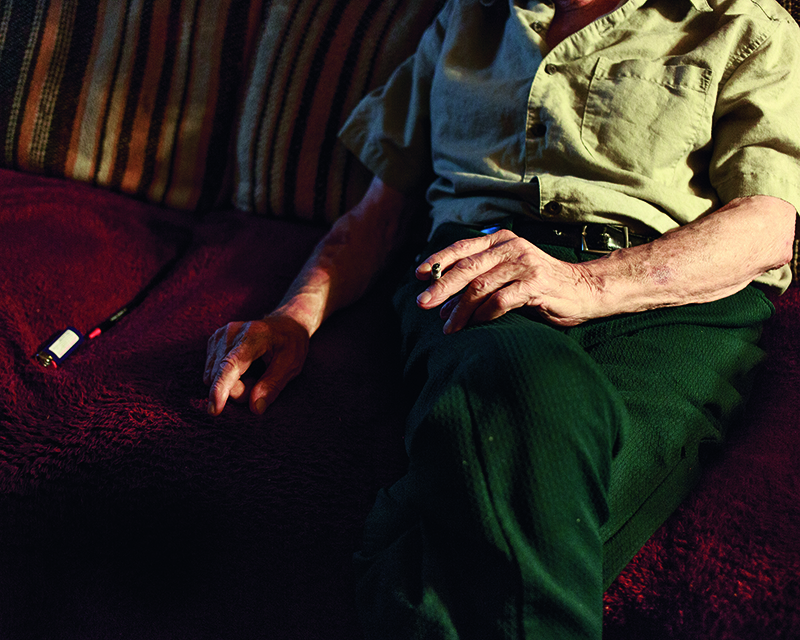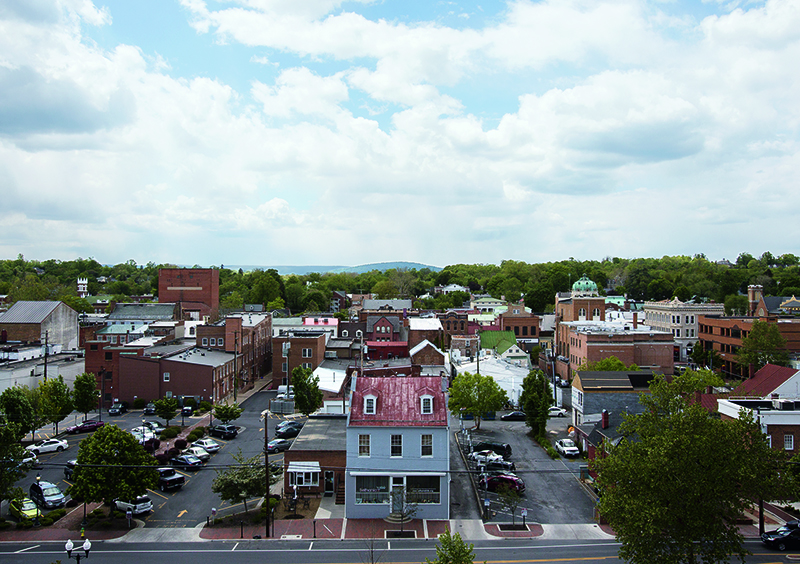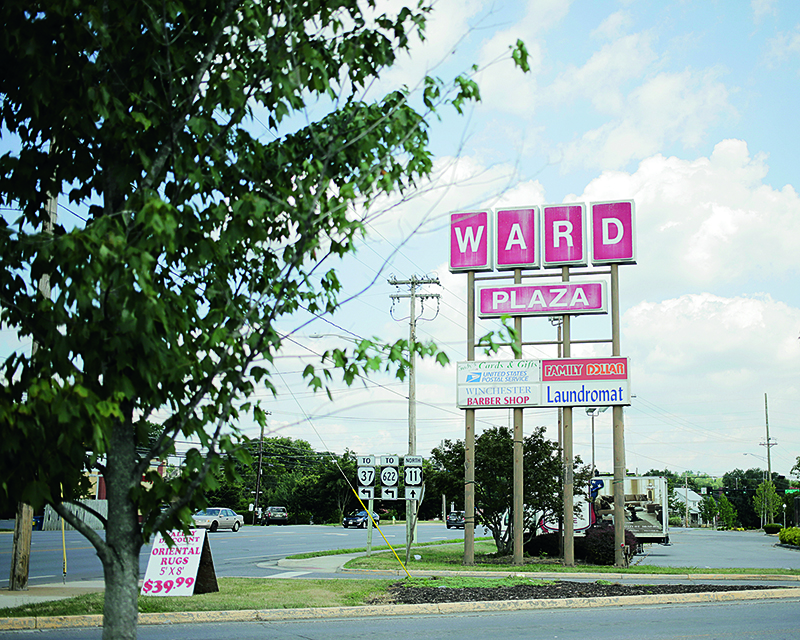
Working With a Photographer Taught Me to See Writing Differently
"I Began to Appreciate Just How Visual the World Out There Was"
On the day that Matt and I first met Jim McCoy, the sun was so bright that his wrinkles looked like wood-grain. I had my notebook out, asking Jim questions about his country music past and his friendship with Patsy Cline, but all I could focus on was that face. Eighty-three years old it was, having absorbed enough mountain sunlight and roadhouse tobacco smoke to make it look almost infinite, beyond time. In the distance, yards and then miles behind him, long grass and Blue Ridge pines swayed and breathed.
Matt moved around us, taking pictures of Jim at rest. We’d come out to Winchester, Virginia as a pair, writer and photographer, having looked for years for an excuse to “do something together,” whatever that might mean. He had a latent interest in art photography and I had a completely untested notion of myself as a feature writer, a chronicler. Most of my work to that point had been book or movie reviews, and I was looking around for ways to actually report. So when I pitched a little weekend travelogue to coincide with the 50th anniversary of Patsy’s death, The Morning News threw a few bucks in to help cover Matt.
From that initial weekend, we kept getting invited back by locals, all of whom seemed to have a close connection to Patsy or knew someone who did. More than anyone, we were recommended to meet Jim McCoy, who knew her intimately, who played music with her, who was a pallbearer at her funeral, and who now owned a honky-tonk in the mountains, the Troubadour Bar & Lounge. And since Jim lived up there next to the Troubadour, since this was in fact his ancestral land and the place where he was raised without electricity, that’s how we found ourselves in his yard, taking notes and staring at the sunset-on-adobe texture of his elderly face.
 Jim McCoy smoking. Photo by Matthew Lincoln Yake.
Jim McCoy smoking. Photo by Matthew Lincoln Yake.
He wanted us to admire that huge sky and his place among it. He wanted us to see the tomatoes he was growing in his garden, some of which ended up on burgers and the salad bar inside the Troubadour. Jim wanted us to appreciate every nuance of his outdoor picnic area: the big grills, the bar, the outside plumbing, and most of all, the massive fake six-shooter pistol that they fill with lit logs to make the barrel smoke. Then he took us into the Troubadour itself, announcing, “That’s how you can tell a redneck. They never take the Christmas lights down.”
The decor bore him out: glowing red and blue, neon reflecting in hundreds of small picture frames lining the wall. There were old snapshots and mementos of previous Troubadour nights, as well as memorabilia and merchandise from Jim’s long career at the height of regional country music fame. Matt—tall, boy-scout kind, and prolifically self-tattooed—maneuvered throughout the room, taking long shots and wide ones, getting a detail or a full scene.
 The Troubadour Lounge. Photo by Matthew Lincoln Yake.
The Troubadour Lounge. Photo by Matthew Lincoln Yake.
Hours later, after karaoke night had transformed the Troubadour into a loose and louche country free-for-all, I asked Matt in the car why he shot what he did.
“You just never know what’s going to stand out when you look back on it later,” he said. I could relate to this from notetaking. Sometimes a little detail jotted down in passing becomes reflective of a larger theme when you revisit notes like that. But most of the time, the notes are an excuse to simply remember the conversation as it happens, to make myself more invested and aware of the experience of talking to someone. I hope that, as I talk to them more and more, their behavior will ultimately be as revealing or important as what they said. That was still just a hunch, however, since these trips to Winchester were my first experiences with deep reportage—scene-based stuff, background interviews, searching for a story inside a hundred little strands.
Matt and I handed in our first piece about Patsy. It was much longer than I anticipated, which meant we used more of Matt’s pictures than expected. I kept coming back to meet Jim and get to know him, to interview anyone who could talk about Winchester’s history. I read a lot in the weeks between visits, and kept arriving with new threads to pull on. And whenever possible, I asked Matt to join along and bring the camera. You just never know what’s going to stand out when you look back on it later.
*
Unavoidably, the story of Winchester is one about class. It was founded before the French and Indian War, had repeatedly been a battlefield, had hosted major historical figures, and the local old money was still seen and felt. Historical mansions, touristy development, and lots of small-town ritual all made it feel somewhat stuck in time, even though the population was growing and diversifying. This is what I wanted to somehow show—how a place can grow more small-d democratic but remain strictly stratified. I needed to see the whole of the community and show how they were all participating in one story. What could I learn about the development and dissolution of small communities if I saw this one from all angles, including Jim’s as well as that of doctors, local historical figures, businesspeople, black and Hispanic people, women, and more?
Matt and I often saw different strata within a couple hours. Our friendly interviews had given us a word-of-mouth reputation for trustworthiness, so any door we looked for was mostly open to us. We visited commercial real estate developers and local produce barons, just as we visited diner owners and social workers.
“Exhibit enough of an interest in people’s personal efforts and they always start to trust you. The words tumbled out. The big narrative of the town came slowly into place.”
We worked together well. I’d put the people at ease by sitting down and engaging them with the notebook. Know enough about people’s land and they always start to trust you, so the unstructured conversations went on until I connected something to a narrative I knew from elsewhere. Meanwhile, Matt would stalk their space, whether a garage or an office, taking pictures of their things and asking questions. How’d you get this thank-you trophy from the Frederick County Realtor’s board? Where was this family photo taken? Did you paint this mallard watercolor? Exhibit enough of an interest in people’s personal efforts and they always start to trust you, as well. The words tumbled out. The big narrative of the town came slowly into place.
Winchester’s very interconnectedness was a story in itself. The fact that the town had been so close-knit and continuous was a major reason why its current changes were so convulsive. The farmers knew the politicians, the restaurateurs went to high school with the slumlords. The most historically wealthy family owned the daily newspaper. Matt and I had thought about what a collection of these stories might be: a series of articles, an essay collection, maybe a filmed documentary. It needed to be something that could accommodate the kaleidoscopic nature of these connections.
 Downtown Winchester, VA. Photo by Matthew Lincoln Yake.
Downtown Winchester, VA. Photo by Matthew Lincoln Yake.
It turned out to be a narrative nonfiction book, illustrated with his color photos. But that took five years and many drafts as I learned how to actually fill a manuscript of that size. Along the way, my writing, I see now, was influenced by Matt’s photographs. The things he found interesting through a lens weren’t always the same I appreciated researching or reporting, but sometimes they were, and either way we had a built-in way of discussing the differences between the two formats.
A picture captures a moment, a sliver, and though it might reverberate with outside significance, it stands alone, unhurried, a trickster outside time. Writing, meanwhile, is only time: it stretches days into novels, compresses dinners into one-act plays, and summarizes historical epochs in paragraphs. What could photographs convey that writing couldn’t, and vice versa? This granted metaphysical stakes to my work for the first time: What did I deem worthy of seeing, and how can I use writing to best describe it? I didn’t have answers to those questions at that point, but the process of finding them is what made me able to imagine my story on the scale it required
*
One day we woke on a 20-head cattle farm on voluminous private acreage. I stood on the porch of the guest apartment that our host, a retired commercial realtor, had built on top of his garage. It was about 7:30 in the morning, early spring, and a gothic haze still lingered in the fields around us. I could see trees poking out above the mist but little else. Sun comes slowly to the northern Shenandoah, and the fog lifted so imperceptibly slowly that the cows simply seemed to materialize: first a nose shined in the white vapor, then an entire, unmoving cow face surrounded it like an oil painting in a haunted house. Then the process repeated 19 silent times.
“It wasn’t that I began ‘thinking like a photographer,’ whatever that means. More like, I began to appreciate just how visual the world out there was, what a huge role that scenes and colors played in everyone’s relationship to the place.”
Later that day, we were on Highway 7, the Harry Flood Byrd Highway, named for who I now knew to be the region’s eminence grise, the man who embodied all the poisonous qualities of old money and judgmental conservatism. I was explaining the man’s steamrolling career in politics, from the Virginia State House up to top Democratic Senator for 30 years, when Matt pulled off on the shoulder. He rolled to a stop, grabbed his bag from the back seat, then ascended the metal highway barrier and pointed his lens into the receding hills. I followed him out and we both observed the Olympian rays of the sun setting behind a range of staggered peaks. And in this heavenly glow sat a small fleet of identical McMansions, each on its own private hill, getting its own custom serving of mythic sunbeams. Matt snapped his photos. He was unhappy. Couldn’t get the shadow layers right, couldn’t get the gradations of blue and gold. We never did anything with his photos, but those houses became a kind of keepsake memory for me. The grandeur of them and the whole ritual of stopping and slowly snapping a camera in search of the right replica.
 Winchester’s Ward Plaza. Photo by Matthew Lincoln Yake.
Winchester’s Ward Plaza. Photo by Matthew Lincoln Yake.
It wasn’t that I began “thinking like a photographer,” whatever that means. More like, I began to appreciate just how visual the world out there was, what a huge role that scenes and colors played in everyone’s relationship to the place. The rednecks never take the Christmas lights down, the farmers get to see the ghost beef’s daily reveal, the wealthy watch Zeus’s sunset. People were possessive of their views, those colors tinted their lives for decades. That’s one thing they all had in common, that’s one thing they were all protecting. And once I understood that, I was close to understanding why people tell stories in the first place.
First-time authors take an enormous step into unseen territory every day, trusting themselves to complete something that they haven’t ever done before and which isn’t even visible while still in progress. You have to trust your vision, your way of seeing things, in order to produce enough to fill those pages honestly. You have to feel entitled to your explanation of reality. Matt’s photos were what gave me that feeling. They were proof that I was writing about real people in real clothes, amid real scenery, their heads full of real worry and memories. As I remembered interviewees, their faces and stories were always subject to my interpretation and understanding. In photographs they were self-possessed. That was how they needed to be presented in my writing. Those photographs are what put need in my writing in the first place. No book can live without it.
John Lingan
John Lingan is the author of Backbeats: A History of Rock and Roll in Fifteen Drummers; Homeplace: A Southern Town, a Country Legend, and the Last Days of a Mountaintop Honky-Tonk; and A Song for Everyone: The Story of Creedence Clearwater Revival, named one of the Best Music Books of 2022 by Variety. He has written for The New York Times Magazine, The Washington Post, The Nation, and The Oxford American, among many other publications. He lives in Maryland.



















